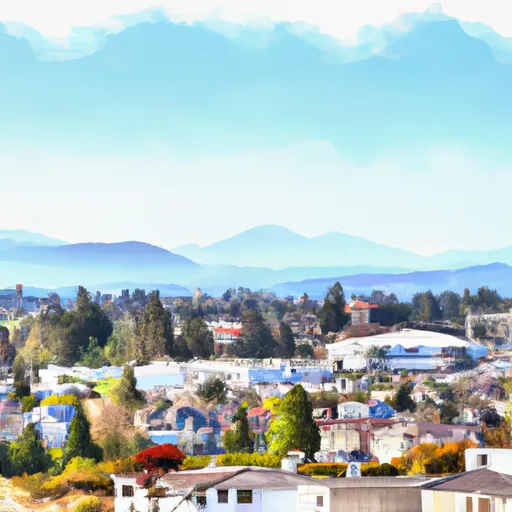-
 Snoflo Premium
Snoflo Premium
Get unlimited access to all our content
With no Ad interruptions! - Start Your Free Trial Login with existing account
Grapeview
Eden Index
Climate
7.3
•
Recreation
4.3
•
Community
1.1
•
Safeguard
4.7/10

Grapeview is located in Mason County, Washington, and is known for its mild climate and beautiful natural surroundings. The area has a Mediterranean-type climate with dry summers and wet winters. The nearby Puget Sound and Hood Canal provide a rich marine environment, making fishing and shellfishing popular recreational activities. The area also boasts numerous hiking trails, including the popular 5.5-mile hike to the top of Mount Ellinor, which offers stunning views of the surrounding Olympic Mountains. Hydrology constituents include the Skokomish River, which flows into the nearby Hood Canal and supports a variety of fish and wildlife species. Additionally, Grapeview is home to several freshwater lakes, including Mason Lake and Island Lake, which offer opportunities for swimming, boating, and fishing.
What is the Eden Index?
The Snoflo Eden Index serves as a comprehensive rating system for regions, evaluating their desirability through a holistic assessment of climate health, outdoor recreation opportunities, and natural disaster risk, acknowledging the profound impact of these factors on livability and well-being.
Climate Health Indicator (CHI): 7.3
Grapeview receives approximately
1519mm of rain per year,
with humidity levels near 88%
and air temperatures averaging around
11°C.
Grapeview has a plant hardyness factor of
8, meaning
plants and agriculture in this region tend to thrive here all year round.
By considering the ideal temperature range, reliable water supplies, clean air, and stable seasonal rain or snowpacks, the Climate Health Indicator (CHI) underscores the significance of a healthy climate as the foundation for quality living.
A healthy climate is paramount for ensuring a high quality of life and livability in a region, fostering both physical well-being and environmental harmony. This can be characterized by ideal temperatures, reliable access to water supplies, clean air, and consistent seasonal rain or snowpacks.
Weather Forecast
Streamflow Conditions
Puget Sound
Area Rivers
Puget Sound
Snowpack Depths
Puget Sound
Reservoir Storage Capacity
Puget Sound
Groundwater Levels
Recreational Opportunity Index (ROI): 4.3
The Recreational Opportunity Index (ROI) recognizes the value of outdoor recreational options, such as parks, hiking trails, camping sites, and fishing spots, while acknowledging that climate plays a pivotal role in ensuring the comfort and consistency of these experiences.
Access to outdoor recreational opportunities, encompassing activities such as parks, hiking, camping, and fishing, is crucial for overall well-being, and the climate plays a pivotal role in enabling and enhancing these experiences, ensuring that individuals can engage in nature-based activities comfortably and consistently.
Camping Areas
| Campground | Campsites | Reservations | Toilets | Showers | Elevation |
|---|---|---|---|---|---|
| Twanoh State Park | 47 | 46 ft | |||
| Hamma Hamma | 15 | 556 ft | |||
| Jarrell Cove State Park | None | 50 ft | |||
| Joemma Beach State Park | 19 | 86 ft | |||
| Penrose Point State Park | 82 | 15 ft | |||
| Seal Rock | 41 | 228 ft | |||
| Collins | 16 | 281 ft | |||
| Belfair State Park | 170 | 14 ft | |||
| Dosewallips State Park | 125 | 20 ft | |||
| Scenic Beach State Park | 52 | 214 ft |
Nearby Ski Areas
Catastrophe Safeguard Index (CSI):
The Catastrophe Safeguard Index (CSI) recognizes that natural disaster risk, encompassing floods, fires, hurricanes, and tornadoes, can drastically affect safety and the overall appeal of an area.
The level of natural disaster risk in a region significantly affects safety and the overall livability, with climate change amplifying these risks by potentially increasing the frequency and intensity of events like floods, fires, hurricanes, and tornadoes, thereby posing substantial challenges to community resilience and well-being.
Community Resilience Indicator (CRI): 1.1
The Community Resilience Indicator (CRI) recognizes that education, healthcare, and socioeconomics are crucial to the well-being of a region. The CRI acknowledges the profound impact of these elements on residents' overall quality of life. By evaluating educational resources, healthcare accessibility, and economic inclusivity, the index captures the essential aspects that contribute to a thriving community, fostering resident satisfaction, equity, and social cohesion.

